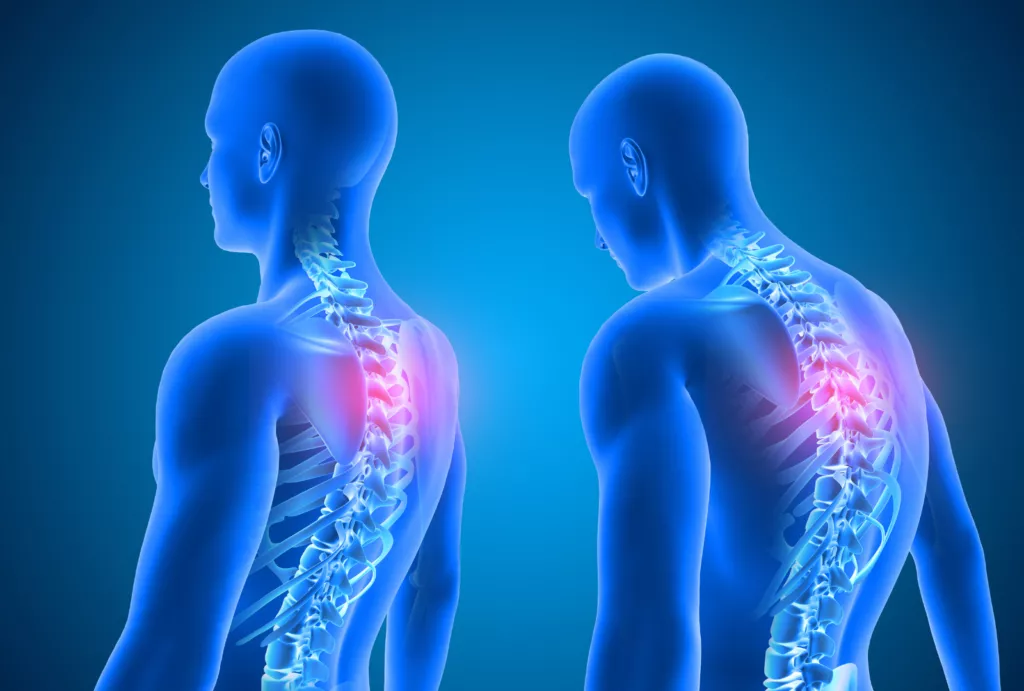Compressed Nerves (Pinched Nerve): Causes, Symptoms &Treatment
Updated:

A pinched or trapped nerve is a nonmedical term for a compressed nerve root. Any nerve root outside of a person’s spinal cord but still within the spinal canal can become compressed for a variety of reasons. A person with a nerve root compression may experience one or all of: tingling, numbness, weakness and importantly pain. Mildly or intermittently trapped or inflamed nerve roots usually resolve over time with at-home care. However, more severe cases may require medical input or expert surgical treatment.
These symptoms may be felt anywhere in the area of the limbs served by the nerve. The body has an anatomical wiring loom, (myotomes and dermatomes) knowledge of which helps your surgeon diagnose which nerve root is likely to be compressed. For example, a trapped nerve in the lower back may also cause pain in the hips, groin, buttocks, front of the thigh, back of the thigh, calf, shin, or foot depending on which nerve root is compressed.This article explains the symptoms of trapped nerves, their causes, and how they are diagnosed. It also discusses possible complications and treatment options. Contact Dan Fagan FRCS and the experts at Spine Art today to learn more.
What Is a Compressed Nerve?
Nerves extend throughout your body with fibers and neurons from your brain and spinal cord, sending important electrical messages. If you have a compressed nerve, your body may send you warning signals, such as pain! Don’t ignore these warning signs. The earlier you receive a diagnosis and treatment plan for nerve root compression, the quicker you’ll find relief. When surrounding tissues press on peripheral nerve roots (where peripheral nerves “exit” your spinal cord), it can cause pain, numbness, weakness and tingling in different body areas. This is called radiculopathy. There are several types of radiculopathies based on where the pinched nerve is along your spine:
- Neck (cervical radiculopathy). This is a common problem.
- Middle to the upper back (thoracic radiculopathy). This is very rare!
- Low back (lumbar radiculopathy). This is very common.
Other Types of Pinched Nerves
The experience of your limb “falling asleep” is also an example of a pinched nerve. This is the briefest form of a pinched nerve. Poor positioning while leaning over the back of a chair or when asleep, can pinch a single peripheral nerve (which is made up of several spinal nerve roots joined together!), giving you that tingling or numb feeling. It goes away shortly after you move out of the position that caused it. Examples of pinched nerves elsewhere in your body include:
- Median nerve in your wrist: Carpal tunnel syndrome.
- Nerves in your lower neck and upper chest: Thoracic outlet syndrome.
- Peroneal nerve on the top of your foot: Fibular tunnel syndrome.
- Radial nerve in your elbow: Radial tunnel syndrome.
- Ulnar nerve in your elbow or wrist: Ulnar nerve entrapment.
- Lateral femoral cutaneous nerve in your thigh: Meralgia paresthetica.
- Pudendal nerve in your pelvic area: Pudendal neuralgia.
- Sciatic nerve in your buttock, or leg: Piriformis syndrome. Not sciatica!
- Tibial nerve in your heel or sole of your foot: Tarsal tunnel syndrome.

Peripheral Nerve Compression Causes
A compressed nerve occurs when surrounding tissues press against your nerves. Swelling and inflammation can also compress peripheral nerves. Conditions that can lead to pressure on these nerves include:
- Rheumatoid Arthritis: This autoimmune condition causes inflammation in the joints that may put pressure on nearby nerves.
- Osteoarthritis: This is a condition that breaks down cartilage in the joints. As the cartilage wears away, the bones rub against each other. Your body responds by growing new bone around the joint. Bone spurs (or osteophytes), an overgrowth of bone, commonly form and can press on nearby peripheral nerves near major joints.
- Injury: Injuries that affect your bones, joints, ligaments, or muscles can cause a compressed nerve, whether due to the displaced or damaged tissue or the swelling that develops following an injury, or deformity following a fracture.

Symptoms of a Compressed Nerve
If you have a compressed nerve, pain may be your only symptom, or you may experience other symptoms without pain. Some of the most common symptoms of a compressed nerve include the following:
- Localized pain such as pain in the hand at night or on waking (carpal tunnel syndrome)
- Numbness or tingling in the same area as the pain
- A burning sensation (less common)
- Muscle weakness such as in the hand
- The feeling of having your foot or hand “fall asleep”
Symptoms can worsen when you try specific movements, such as turning your head, straining your neck, or when you’re sleeping. Early diagnosis is essential to prevent worsening symptoms. Trapped peripheral nerves can be a cause of work-related disability (Work Related Upper Limb Disorder).
Diagnosis
If your pinched nerve isn’t responding to at-home treatment, like rest and pain relievers or even a wrist splint, it’s probably time to consult with a medical provider. To find the root cause of the pinched nerve, they will physically examine the affected area to look for muscle weakness, check for changes in reflexes, and ask about the sensations you’re experiencing. If necessary, they may recommend one or more of these tests to find the source of the problem:
- X-Ray: These tests can show bone changes in joints that may affect nerves, like healed fractures or osteoarthritis.
- Ultrasound: Can be useful in cases of Meralgia Paraesthetica.
- Magnetic Resonance Imaging (MRI): An MRI will show if the symptoms are due to spinal nerve root compression.
- Electromyography (EMG) & Nerve Conduction Study: These tests are very useful and can help determine if a nerve works as it should. They can also help your surgeon determine whether symptoms are due to pressure on spinal nerve roots, peripheral nerve entrapment or from an entirely different neurological condition such as peripheral neuropathy (quite common).
Treatment for Compressed Nerves
What is the typical treatment for a trapped peripheral nerve? Most patients don’t require surgery although this is very effective and low risk. Instead, your provider may recommend one or more of the following treatments to help you find relief:
- Time & Rest: For many people, time takes care of a pinched nerve and doesn’t require formal medical treatment. Your symptoms may subside in a few days or weeks.
- Ice & Heat: Apply ice and heat to any swollen area for temporary relief.
- Over-the-Counter Pain Relievers: Nonsteroidal anti-inflammatory drugs (NSAIDs) may help your symptoms. NSAIDs include ibuprofen and naproxen. To take these medications safely, be sure to follow the instructions on the package.
- Immobilisation Devices: Depending on the affected area and the cause of the compressed nerve, your provider may recommend wearing a brace to immobilise that area of your body. This limits movement and range of motion, giving your nerves the proper time to settle.
- Corticosteroid Injections: These can be very effective, often delivered by a specialist orthopaedic surgeon.
- Physical Therapy: Doing stretches and other light exercises can help ease pressure on your nerves and relieve pain. Talk to your provider about what exercises are best for the symptoms you’re experiencing.
When nonsurgical treatment has failed to treat a compressed nerve, surgery may be required. The type of surgery performed depends on the cause of the pinched nerve and the area affected, such as Carpal Tunnel Decompression or Cubital Tunnel Decompression. Again, performed by specialist orthopaedic surgeons.
Prevention Strategies to Avoid Pinched Nerves
It’s not possible to prevent all occurrences of nerve compression. However, taking specific actions can help lower your risk. For example:
- Maintain a healthy weight.
- Do stretches to keep your muscles flexible and strong.
- Avoid sitting or lying in the same position for too long or crossing your legs for an extended period.
- Limit repetitive motions (such as typing) or take frequent breaks.
When to Seek Medical Attention
If your pinched nerve symptoms last longer than a week and aren’t improving with at-home care, consult with a healthcare provider. They can determine the underlying cause of your condition and recommend a treatment plan. If you experience sudden muscle weakness or intense pain, see a medical provider as soon as possible to avoid further complications.
Contact the Team at Spine Art for Pinched Nerve Relief
Compressed nerves are a common occurrence. It’s easy to see how just one of the many branches of peripheral nerves in the body can become pinched. However, having a pinched nerve doesn’t mean living with lasting pain and abnormal sensations. Speak with the healthcare providers at Spine Art if you have a trapped nerve and your symptoms aren’t improving. We can check that the symptoms are not from a trapped spinal nerve root and we’re available to help and explore your treatment options. Contact our team today to learn more or schedule an appointment.








